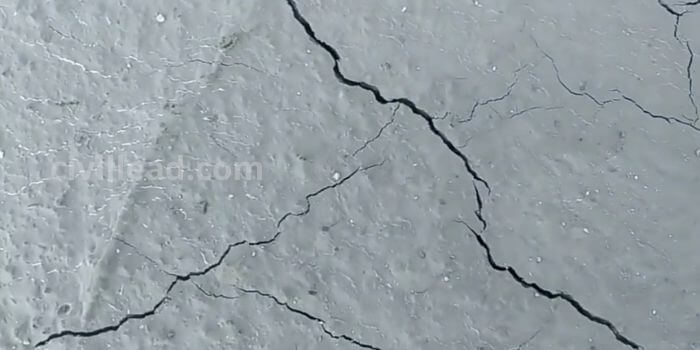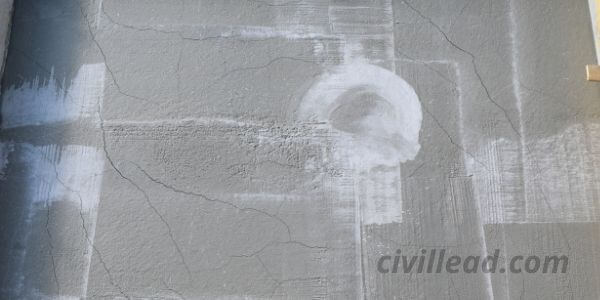Table of Contents
Cracks in Concrete Slabs
Generally, you would have observed when you cast concrete slab, and after 5 to 6 hours or the next day, there are hair cracks in concrete slab.
Many questions come to your mind, like why do these cracks develop? How can we stop it? Will my slab break? etc?
Concrete cracks are not suitable for any building or structure. Cracks provide a path for moisture and oxygen to react with steel reinforcement, which leads to corrosion.
Due to corrosion, steel volume may increase 2 to 6.5 times than its original volume, which may damage the structure, and it may collapse.
So today, in this post, I am going to answer all these questions which bother you.
So Let’s start
Reason for Cracks in Concrete Slab after Casting

Temperature
Environment Temperature: It is the most critical and ample reason for cracks in concrete. Environmental temperature is most vital for concreting.
If the temperature is very high, water present in concrete will evaporate, and the concrete’s plastic shrinkage will occur. Due to plastic shrinkage, cracks will develop on the concrete surface.
Concrete Temperature: As per the ASTM C1064 code, the concrete temperature should be 26.7°C to 35°C. If it is more than 35°C, ice should be added to low its temperature.
As per the AS (Australian Standards) code, the concrete temperature should be 5°C to 40°C. Generally; we follow the ASTM c1064 code.
Water-Cement Ratio
It is another main reason for cracks in concrete. The water-cement ratio should be as per the design mix of concrete grade.
If we increase the quantity of water bleeding of concrete will start that will develop cracks on the concrete surface.
Usually, during concrete casting mistri tells them to increase the water quantity because it is difficult for him to work with tight concrete.
If on his suggestion we increase the quantity of water after concrete compaction excess water will come out on the concrete surface with cement slurry and definitely, cracks will develop on that surface.
Vibration Frequency
It is another crucial reason for cracks in concrete. Excessive vibration may cause cracks in concrete.
Extreme vibration settles down the coarse aggregate at the bottom and fine aggregate at the top.
Excess quantity of fine aggregate at the top is not acceptable, and it is the main reason for cracks in concrete.
Presence of Silt in Sand
If the sand used in concrete contains silt, then it can develop cracks in the concrete. If sand used in concrete has silt in excess quantity, it will not make the proper bond with cement. This weak bonding develops cracks in concrete.
Steel temperature and Lubrication
If steel reinforcement’s temperature is high thermal expansion may occur, which may develop cracks in concrete.
And if there is shuttering oil on the surface of steel reinforcement, it will not make the proper bond with concrete which causes cracks may develop in concrete.
The difference in Slump Value
If we are doing mass concrete, there are several batches of concrete needed. If there is a significant difference in the slump value of concrete from different batches, may develop concrete cracks.
Type of Cement
Cement should be selected as per the nature of the job. Improper selection of cement may generate cracks in concrete. For instance, if we use Rapid hardening cement for slab casting, it will develop concrete cracks.
Improper Centering & Shuttering
If the centring and shuttering used for slab casting are not correctly assembled, it may settle during concrete placing, and cracks will develop in the concrete.
Overheating of shuttering material
Cracks in concrete may also develop hardly due to the shuttering material’s heating, especially for steel shuttering. But the effect is minor.
Also, Read - Sunken Slab - Uses, Advantages And Disadvantage
How can we prevent cracks in concrete slabs?

- Avoid concreting in hot weather. If the temperature is above 35 c in the daytime, try to start concreting in the morning or evening when the temperature is low.
- Don’t add excess water to concrete; always follow the standard specification of the design mix of concrete grade.
- Avoid excessively vibration. Vibration should be done as per the need.
- Avoid using sand that has excessive silt content. Silt content in the sand should be within the limit of 5 to 6%.
- The temperature of steel should be expected, and it should be free from any lubrication.
- There should not be a notable difference between slump values of concrete of different batches during mass concrete.
- The selection of cement should be appropriately made as to the nature of the work.
- Installation of formwork should be done correctly. It should be double-checked, before concrete placing and one skilled person should supervise it during the concrete placing to avoid any accidents.
I hope now you have enough information about the cracks in concrete slab. If this article helps you, please share it if I have missed any reason for cracks in the concrete slab, waiting to hear from you in the comment section.
Thanks!
Also, Read
Difference Between Singly and Doubly Reinforced Beam
What is Concrete Cover? Clear Cover, Nominal Cover and Effective Cover.
Difference Between One way and Two way Slab.
Bar Bending Schedule (BBS) – Importance, Advantages, Preparation
Compressive Strength of Cement Concrete, Cube Test Procedure
Concrete Mix Ratio – Types, Proportioning of Concrete Mix and Methods